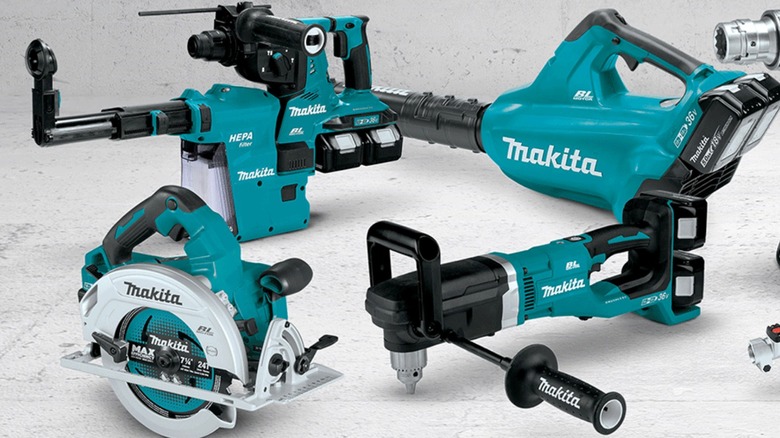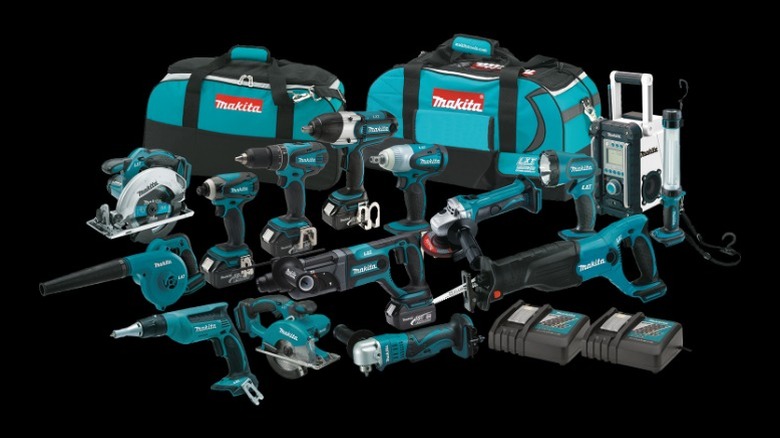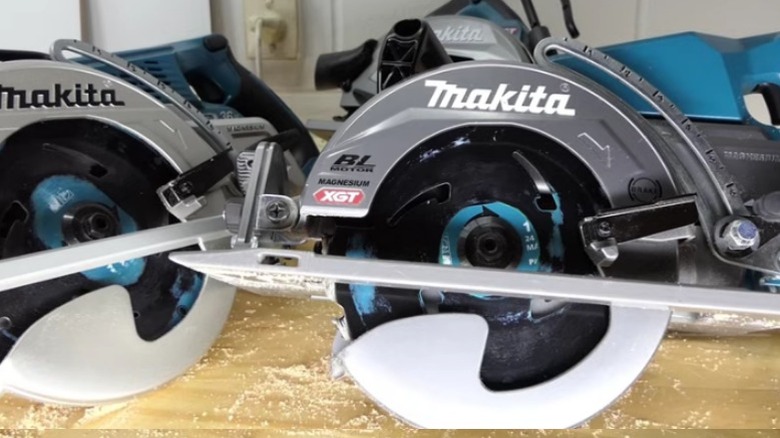What Is Makita's X2 Line And How Is It Different From The LXT?
Makita is one of the top power tool brands on the market. The company has a well-earned reputation for power, reliability, and the integration of cutting-edge technology in its tools. This makes Makita a popular choice among both seasoned professionals and beginners who are looking to build up their tool selection. It's important that buyers know exactly what kind of power-delivery system they're getting when it comes to any power tool brand — particularly when looking at cordless tools. Some brands have more than one battery system, while offering batteries that have different voltage outputs. However, sometimes these systems have specific requirements and aren't always cross-compatible.
Makita offers a few different lines of battery-powered tools. There is the heavy-duty XGT 40V-80V line and the compact CXT 12V line, but most customers probably have their eyes on the popular midweight LXT and X2 lines. Before committing to a purchase, it's important to know what distinguishes the LXT product lines and what advantages both of them have to offer. Knowing more about what separates them will help you to understand what it is you're buying and make sure that you get the right tool system for your needs.
What is Makita LXT?
LXT (Lithium-Ion Xtreme Technology) is the name that Makita has given to its primary line of cordless power tools. The line was first introduced in 2005 as a means of creating lighter battery-powered tools with longer runtimes and faster charging than the 7.2V battery drum-powered tools that the company had been using since it first started releasing cordless tools in 1978. According to Makita, "The LXT System is the world's largest compatible cordless tool system powered by 18V slide-style batteries." Makita has produced over 325 tools that are compatible with this system, making it easy for craftspeople to get the tools they need without having to invest in separate batteries.
Several LXT tools use brushless motors that enable cooler and more efficient operation, prolonging the life of the tool. They have Starr Protection Computer Controls which monitor the flow of energy between the battery and the tool as you use it in order to protect it from overload, over-discharge, and overheating. The LXT batteries come in 18V and 36V outputs and a wide range of ampere-hour capacities. This gives users separate options for lightweight handheld tools, such as drills and oscillating multi-tools, that don't require an excess of power, while also providing for heavy tools, such as chop saws and vacuums that require a bit of extra juice.
These batteries are not interchangeable, however. 18V LXT tools require 18V batteries and 36V LXT tools require 36V batteries. Makita appears to have started phasing its 36V tools out, though. While Makita still sells 36V LXT batteries, all of the 36V power tools currently listed on the company's website are part of the X2 system. This means that the current LXT lineup is pretty much exclusively 18V tools.
What is Makita LXT X2?
The X2 product line, on the other hand, is a more recent addition. Its naming designation can be a little bit confusing since it might lead you to believe that the X2 is an entirely new system with its own line of batteries, but this isn't the case. It's an extension of the existing LXT system that uses the same 18V lithium-ion batteries. It simply uses them in its own unique way. Makita's X2 power tools all require 36V of power to operate, but they manage to do so without needing the user to purchase LXT 36V batteries. Instead, they have two battery ports that allow the user to plug in two LXT 18V batteries for a combined 36V of power. This is handy for a couple of different reasons.
The first reason is that it will spare Makita users from needing to invest in the 36V LXT batteries at all. This saves them money (as the 36V batteries tend to be more expensive) and it saves them the hassle of needing to keep track of two different lines of batteries and their respective chargers. They will instead be able to use a single collection of 18V batteries to power both their 18V LXT and 36V X2 tools.
The second reason is because the X2 system is efficient. "Makita's new Brushless X2 tools are powered by two 18V LXT batteries for maximum power, speed, and run-time," says Makita. "The LXT Advantage technology is at work across the system so you'll get longer motor life, efficient power management, and the industry's fastest-charging times –- all in One System using the same batteries and chargers."
Which is more powerful: X2 36V or XGT 40V?
There's no denying that the X2 tools are convenient and Makita is more than eager to proclaim the power and efficiency of the X2 system, so it makes sense that it would eliminate an unnecessary battery line. That said, there are those who might wonder how these relatively new 36V X2 tools stack up against the slightly more powerful XGT 40V tools.
The YouTube channel Tools & Stuff reviewed several of these tools. He compared the XGT 40V GSR01 circular saw to the 36V X2 XSR01 circular saw. He found that the XGT saw was fantastic for rip cuts, but it struggled when it came time to cut across the grain. Even so, he said that the 40V was substantially lighter and marked a significant improvement in performance over the 36V. The X2 offered 5,100 RPM while the XGT had a colossal 6,400 RPM, which gave it a whopping 1,300 more RPM and a significant boost in cutting power. He also compared the reciprocating saws – however, he found that they were much closer in performance with the 40V being faster through wood and the 36V being better when it came to cutting metal.
Voiceless Tool Reviews did some testing where they compared X2 36V and XGT 40V augers and found that they had reasonably comparable performance. Though, it seemed that the 40V had a slight advantage in most kinds of soil with a wider variety of auger sizes.



